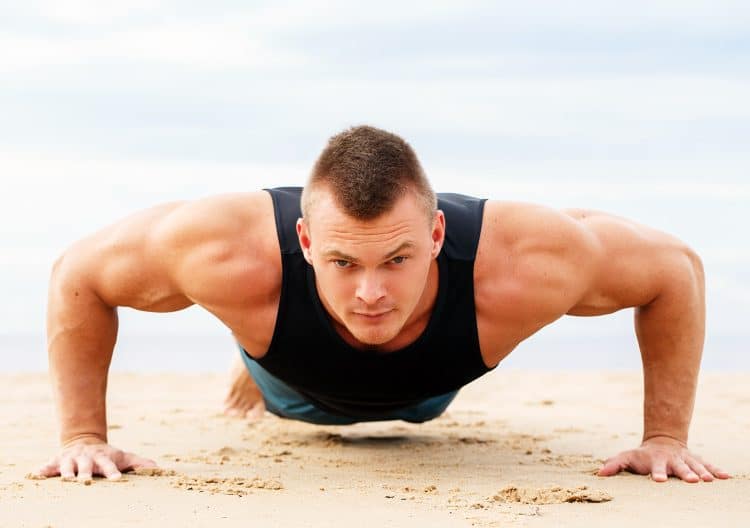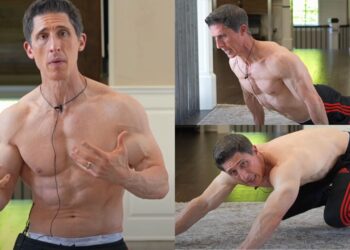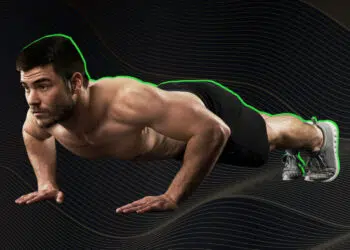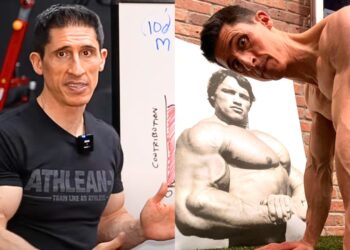Most bodybuilders use a combination of free-weight exercises and resistance machines to build bigger muscles, which is a process called hypertrophy. But what if you can’t make it to the gym or just feel like using a different training method?
You could use resistance bands, but as valuable as they can be, even pumping rubber is not always convenient or possible.
Another option is bodyweight training, also known as calisthenics.
Of all the bodyweight exercises available, push-ups are arguably the most popular and widely performed. Athletes from all sports do push-ups to develop upper body endurance, and they’re also a big part of military training.
But, can push-ups build muscle?
Providing you do enough reps or choose a challenging push-up variation, you CAN build bigger muscles with push-ups.
Level Up Your Fitness: Join our 💪 strong community in Fitness Volt Newsletter. Get daily inspiration, expert-backed workouts, nutrition tips, the latest in strength sports, and the support you need to reach your goals. Subscribe for free!
Not convinced? Try these intense push-up variations for bodybuilders.
15 Intense Push-Up Variations
Push-ups primarily work your pectoralis major, triceps, and deltoids. This means they compare favorably to most freeweight and machine chest exercises, including barbell and dumbbell bench presses and the chest press machine. You can do push-ups anywhere and anytime, making them the perfect excuse-free chest exercise.

On the downside, regular push-ups involve lifting about 60-percent of your body weight. Unfortunately, this may be too little weight to trigger hypertrophy, especially if you’ve been working out a while.
So, the trick to using push-ups for bodybuilding is to make them harder.
Here are 15 intense push-up variations that should be demanding enough to produce muscle growth.
1. 1 ½ rep push-ups
1 ½ rep push-ups keep your pecs under tension for longer. They produce a deep burn and pump, and you’ll really feel your pecs working.
This simple yet effective push-up variation makes a great finisher after your main chest workout, or you can do them at home when you need a chest training fix but can’t make it to the gym.
How to do it:
- Squat down and place your hands on the floor, so they’re wider than shoulder-width apart. Your fingers should be pointing forward. Walk your feet out and back, so your shoulders, hips, and feet form a straight line. Brace your abs and pull your shoulders down and back.
- Bend your arms and lower your chest to within an inch of the floor.
- Extend your arms and push yourself halfway back up.
- Lower your chest to the floor again.
- Extend your arms and come all the way up.
- That’s one rep; keep going!
2. Resistance band push-ups
Powerlifters and bodybuilders use resistance bands in conjunction with squats, bench presses, and deadlifts to increase the overload as they extend their limbs. You can use this same training method, called accommodating resistance, with push-ups. Start with a light, loop-type band, and progress to a thicker band as your strength increases.
How to do it:
- Hold a loop-type resistance band across your upper back. Get down into the push-up position. Brace your core and pull your shoulders down and back.
- Bend your arms and lower your chest to within an inch of the floor.
- Push yourself back up against the resistance provided by the band.
3. Deficit push-up
With regular push-ups, your range of motion is limited by the floor. Deficit push-ups allow you to descend further, which means each rep involves more work and a longer time under tension than push-ups done with your hands on the floor. Both of these factors may produce greater hypertrophy.
How to do it:
- Create a deficit by placing two dumbbells on the floor, a couple of bumper plates, yoga blocks, or by using push-up handles or parallettes. Whatever you use should be slightly wider than shoulder-width apart.
- Squat down and place your hands on the raised implements.
- Walk your feet out and back so that your legs, hips, and shoulders form a straight line. Brace your core and pull your shoulders down and back. Tense your legs and glutes, too. Tuck your chin in and lengthen your neck.
- Bend your arms and lower your chest down between your hands. Your range of motion will depend on your shoulder flexibility and joint health. However, take care not to hyperextend your shoulders by descending too far.
- Keep your upper arms close to your sides and your wrists straight.
- Push yourself back up and then, at the top of the rep, shrug your shoulders forward to activate the serratus anterior fully.
- Reset your shoulders and then descend into another rep.
4. Decline push-up
One of the simplest ways to make push-ups more demanding is to raise your feet and do decline push-ups. This puts more weight on your arms and also puts your body into a flatter position, so you’ll be working your mid-chest more. Regular push-ups tend to emphasize your lower pecs.
How to do it:
- Set up for push-ups as normal but place your feet on a knee-high chair or bench. Brace your abs and pull your shoulders down and back.
- Without dropping your hips out of alignment, bend your arms and lower your chest to within an inch of the floor.
- Push yourself back up and repeat.
5. Medicine ball push-up
Medicine ball push-ups increase your range of motion and also add an element of instability to create a challenging pec workout. You’ll have to work extra hard to stop the balls from rolling away, increasing muscle activation in the process.
How to do it:
- Place two firm medicine balls on the floor. They should be slightly wider than shoulder-width apart.
- Squat down and place your hands on the top of each ball.
- Walk your feet out and back so that your legs, hips, and shoulders form a straight line. Brace your core and pull your shoulders down and back.
- Bend your arms and lower your chest down between your hands.
- Push yourself back up and then, at the top of the rep, shrug your shoulders forward to activate the serratus anterior fully.
- Reset your shoulders and then descend into another rep.
6. Chaos push-up
This is the perfect exercise for anyone who thinks that push-ups are easy. Your arms shake so much that you’ll feel like you are working out during an earthquake! All that shaking increases muscle recruitment, providing an intense pec workout that’s also good for joint stability. You’ll need a strong resistance band and a power rack for this exercise.
How to do it:
- Tie a strong resistance band between the uprights of a power rack. The band should be reasonably tight.
- Grip the band with an overhand, shoulder-width grip and walk your feet back into the push-up position.
- Bend your arms and start pumping out slow push-ups. Some extraneous movement is inevitable but do your best to control the wobbling.
- Adjust the height of the band according to your strength. The closer the band is to the floor, the more weight is on your arms, and the harder the exercise becomes.
7. Decreasing range of motion push-up
This push-up variation is actually a mechanical drop set designed to extend your set beyond failure. You can use this method with straight bodyweight push-ups, resistance band push-ups, or, as in the video, with chains.
How to do it:
Level Up Your Fitness: Join our 💪 strong community in Fitness Volt Newsletter. Get daily inspiration, expert-backed workouts, nutrition tips, the latest in strength sports, and the support you need to reach your goals. Subscribe for free!
- Adopt the prescribed push-up position.
- Bend your arms and lower your chest to within an inch of the floor.
- Push back up and repeat until you are close to failure.
- Quickly place a 2 to 4-inch object (weight plate, yoga block, thick book, etc.) under your chest and rep out again.
- On nearing failure, place another similar block on top of the previous one and rep out to failure.
- Continue adding objects until you’ve done 3-4 mini-sets. Your last set will consist of small, partial reps.
8. Paused push-up
Paused push-ups make every rep a little longer and therefore more challenging. Also, without the stretch reflex at the bottom of each rep, you’ll need to work harder to push yourself back up. This not only increases muscle engagement but also helps develop explosive power.
How to do it:
- Adopt your usual push-up position. Brace your core and pull your shoulders down and back.
- Bend your arms and lower your chest to within an inch of the floor.
- Pause and hover in this position for 3-5 seconds.
- Drive yourself back up to full arm extension and repeat.
9. Ring/suspension trainer pull-up
Suspension trainer (e.g., a TRX or gymnastic rings) push-ups combine a deficit with instability to really challenge your pecs, triceps, and core. Make this exercise easier by shortening the straps and raising the handles or more challenging by setting the handles closer to the floor or lifting your feet.
How to do it:
- Set your suspension trainer handles to the required height.
- Take a handle in each hand, so your palms face inward, i.e., a neutral grip.
- Walk your feet back and into the push-up position with your arms straight. Brace your core and stabilize your arms.
- Bend your arms and lower your chest down between your hands. Your range of motion will depend on your shoulder flexibility and joint health.
- Keep your upper arms close to your sides and your wrists straight.
- Push yourself back up and then, at the top of the rep, shrug your shoulders forward to activate the serratus anterior fully.
- Reset your shoulders and then descend into another rep.
10. Incline plyo push-up
Incline push-ups involve placing your hands on a raised surface, such as an exercise bench or step. This takes some weight off your arms and makes push-ups easier.
But, before you dismiss this exercise, less weight on your arms means you can do push-ups with more velocity, which increases muscle activation. This is a joint-friendly power push-up that’s safer than clap push-ups.
How to do it:
- Place your hands on a sturdy exercise bench, roughly shoulder-width apart.
- Walk your feet out into the push-up position. Brace your core and pull your shoulders down and back.
- Bend your arms and lower your chest to the bench.
- Extend your arms forcefully so that your hands leave the bench.
- Land on slightly bent elbows and repeat.
11. Feet against a wall push-up
This is a type of decline push-up but, instead of resting your feet passively on a bench or chair, you must forcefully press them against a wall. This significantly increases pec and deltoid engagement, and your core gets a challenging workout, too.
How to do it:
- Get into the push-up position with your feet touching a wall. Brace your core and pull your shoulders down and back.
- Walk your feet up the fall while pressing forward with your arms until your body is parallel to the floor.
- Without moving your feet, bend your arms and lower your chest to within an inch of the floor.
- Push yourself back up and repeat.
12. Hand release push-up
Hand-release push-ups are so-called because you lift your hands off the floor at the bottom of each rep. Because you can only do this with your chest resting on the floor, hand-release push-ups force you to use a full range of motion, making push-ups much more cheat-proof.
As well as ensuring you use a full range of motion for every rep, hand-release push-ups increase upper back muscle activation, making them a more balanced exercise. Finally, by lying flat between reps, each rep starts from a dead stop, which increases muscle activation.
How to do it:
- Kneel down and place your hands flat on the floor, slightly wider than shoulder-width apart. Your fingers should be pointing directly forward. Walk your feet back, making sure your body is straight and rigid; brace your core. Look straight down at the floor.
- Bend your arms and, under control, lower your chest to the floor. Keep your body tense and straight.
- Pull your shoulders down and back and lift your hands a few inches off the floor. Imagine you are doing a bent-over barbell row. Do not arch your lower back.
- Place your hands back on the floor and push yourself back up to return to the starting position. Extend your arms explosively to overcome inertia and increase muscle activation.
13. Deficit push-up/renegade row
This challenging push-up variation doesn’t just work your chest, shoulders, and triceps. Instead, it works your upper back and biceps, too. It’s also a very core-centric exercise. This is the ideal exercise when you are short of time but still want to train your entire upper body and midsection.
How to do it:
- Squat down and adopt the push-up position with a dumbbell in each hand. Your hands should be roughly shoulder-width apart, palms facing inward. Brace your core and pull your shoulders down and back. Make sure your wrists are straight.
- Bend your arms and lower your chest down between your hands.
- Push yourself back up.
- Next, bend one arm and row your dumbbell up and into your lower ribs. Keep your shoulders and hips stationary, and do not bend your legs.
- Lower the weight to the floor and do another push-up.
- Do your next row with the other arm.
- Continue this push-up/row/push-up/row sequence for the desired number of reps.
14. Pike push-up
Most push-up variations target your pecs. This one’s a little different because it focuses more on your deltoids. This is an excellent preparatory exercise for handstand push-ups (#15) and also a great way to train your shoulders without resorting to overhead barbell or dumbbell presses.
How to do it:
- Adopt the push-up position with your hands roughly shoulder-width apart. Brace your core and pull your shoulders back.
- Keeping your legs straight, lift your butt into the air, so your body resembles an inverted V.
- Keeping your hips up, bend your arms and lower your head to within an inch of the floor.
- Push back up and repeat.
15. Handstand push-up
The final push-up variation for bodybuilders is the handstand push-up. This is primarily a deltoid exercise, but your triceps will get a great workout, too. You’ll be lifting your entire body weight with just your arms, so this option is very challenging, especially for heavier exercisers.
How to do it:
- Take off your shoes; the last thing you want is to make this exercise harder by creating extra friction against the wall.
- Find a smooth wall to do your push-ups against, and make sure there are no pictures or other obstructions that will get in your way.
- Squat down and place your hands flat on the floor, about shoulder-width apart. Your fingers should be pointing forward. Put a cushion between your hands for safety if you think you need one. Your hands should be about 12-inches away from the wall.
- Starting with one foot forward and one foot back, kick up and into a handstand, so your feet are resting against the wall. Brace your core and get your balance. Keep your legs straight.
- When you feel stable, bend your arms and lower your head down to lightly touch the floor.
- Extend your arms and push yourself back up.
- On completion, lower your legs back to the floor and stand up. Take a moment to check your balance; it’s not uncommon to feel a little dizzy after doing this exercise.
Related: 13 Next Level Push-Up Variations For Mass, Strength, and Performance
Push-Up Variations – Wrapping Up
Bodybuilders LOVE the bench press, but that doesn’t mean it’s the only or even the best way to work your chest. Push-ups CAN build muscle too, and there are lots of variations you can use to make your workouts more challenging, varied, and fun.
Try doing one set of each of the 15 options outlined above for a tough, no-frills workout you can do anywhere and anytime.
Alternatively, pick just one variation and crank out 100 reps in as few sets as possible.
You can also combine these exercises to create your own variations, such as deficit, decline, resistance band push-ups. Or, for more overload, why not strap on a weighted vest?
Push-ups make a great addition to any bodybuilding workout and also mean that you can train your upper body even when you can’t make it to the gym.
Interested in measuring your progress? Check out our strength standards for Bench Press, Push Ups, Dumbbell Bench Press, and more.








